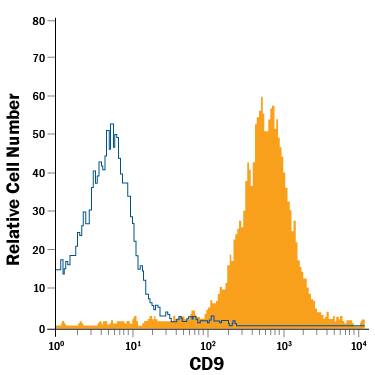Mouse CD9 APC-conjugated Antibody
R&D Systems, part of Bio-Techne | Catalog # FAB5218A


Key Product Details
Species Reactivity
Applications
Label
Antibody Source
Product Specifications
Immunogen
Pro2-Val226
Accession # P40240
Specificity
Clonality
Host
Isotype
Scientific Data Images for Mouse CD9 APC-conjugated Antibody
Detection of CD9 in D3 Mouse Cell Line by Flow Cytometry.
D3 mouse embryonic stem cell line was stained with Rat Anti-Mouse CD9 APC-conjugated Monoclonal Antibody (Catalog # FAB5218A, filled histogram) or isotype control antibody (Catalog # IC006A, open histogram). View our protocol for Staining Membrane-associated Proteins.Applications for Mouse CD9 APC-conjugated Antibody
Flow Cytometry
Sample: D3 mouse embryonic stem cell line
Formulation, Preparation, and Storage
Purification
Formulation
Shipping
Stability & Storage
Background: CD9
CD9 is a 22-25 kDa member of the tetraspanin (TM4SF) superfamily of molecules. Although typology of this family shows a cytoplasmic N- and C-terminus, tetraspanins should not be confused with the MS4A (Membrane-spanning 4 domain) family of proteins. To date, there are more than 30 human tetraspanins, presumably all of which participate in the creation of tetraspanin webs (or multimolecular microdomains) that traverse the cell membrane. As with other superfamily members, CD9 forms homodimers and associates with essentially five classes of molecules: Integrins ( alphaIIb beta3, alpha6 beta4, alpha3-6 beta1), IgSF members (ICAM-1, VCAM-1, IgSF8/EWI-2, CD9P1), ectoenzymes (ADAM-12, MT1-MMP) intracellular signaling moluecules (PI-4K, PKC) and others (CD81, CD63, IL-16, pro-HBEGF). The microdomain complexes both recruit and regulate individual molecules. CD9-containing microdomains reportedly promote gamete fusion while inhibiting monocyte fusion. Cells known to express CD9 are many and varied, and include oocytes, regulatory B cells (in mouse, not human), endothelial cells, platelets, monocytes, keratinocytes, mast cells, and myoblasts. The extracellular domain(s) or mouse CD9 share 80% and 88% amino acid sequence identity with human and rat CD9, respectively.
Alternate Names
Gene Symbol
UniProt
Additional CD9 Products
Product Documents for Mouse CD9 APC-conjugated Antibody
Product Specific Notices for Mouse CD9 APC-conjugated Antibody
For research use only